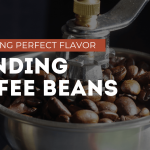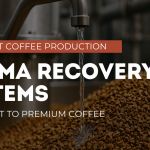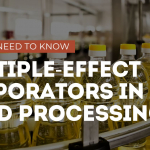Soluble coffee, commonly known as instant coffee, has grown immensely popular due to its convenience and long shelf life. However, producing high-quality soluble coffee requires a series of well-controlled processes, particularly during the drying stage. Drying plays a pivotal role in determining the flavor, aroma, and overall quality of the final product. In this article, we’ll explore the most common soluble coffee drying techniques, how they work, and their impact on the coffee’s characteristics.
Understanding the Soluble Coffee Production Process
Before diving into the drying techniques, it’s important to understand how soluble coffee is produced. The process starts with selecting and roasting green coffee beans, followed by grinding and brewing the coffee to extract its soluble components. After brewing, the coffee extract is concentrated to reduce water content, preparing it for the final drying step.
The drying stage transforms the concentrated coffee extract into a dry, soluble powder or granule, making it ready for packaging and storage. There are two main drying methods used in the industry: Spray Drying and Freeze Drying. Each method has its own advantages and is chosen based on the desired quality, production efficiency, and cost.
1. Spray Drying: The Most Common Method
Spray drying is the most widely used technique in the soluble coffee industry due to its cost-effectiveness and high production capacity.
How Spray Drying Works
- The concentrated coffee extract is pumped into a large drying chamber.
- The extract is atomized into tiny droplets using a high-pressure nozzle or spinning disk.
- Hot air (usually at temperatures between 150°C and 300°C) is introduced into the chamber.
- As the droplets come into contact with the hot air, they dry almost instantly, leaving behind fine coffee powder.
Advantages of Spray Drying
- High Efficiency: Can process large volumes of coffee extract quickly.
- Lower Cost: Compared to freeze drying, spray drying is more affordable.
- Consistent Particle Size: Produces uniform, fine coffee powder.
Disadvantages of Spray Drying
- Potential Flavor Loss: High temperatures can degrade some of the coffee’s aromatic compounds.
- Lower Quality: The final product may lack the complex flavors and aromas of freshly brewed coffee.
Explore more: Advantages and Disadvantages of Spray Drying
2. Freeze Drying: The Premium Option
Freeze drying, also known as lyophilization, is a more sophisticated technique that preserves the coffee’s natural flavors and aromas better than spray drying. This method is commonly used for high-end instant coffee products.
How Freeze Drying Works
- The concentrated coffee extract is frozen at extremely low temperatures (-40°C or lower).
- The frozen coffee is then broken into smaller granules.
- The granules are placed in a vacuum chamber where sublimation occurs.
- Sublimation is the process where ice turns directly into vapor without passing through a liquid phase.
- The water vapor is removed, leaving behind dry coffee granules.
Advantages of Freeze Drying
- Superior Flavor Retention: Maintains the coffee’s original aroma and flavor.
- Better Texture: Produces larger, more visually appealing granules.
- Longer Shelf Life: The freeze-dried coffee is highly stable and resistant to moisture.
Disadvantages of Freeze Drying
- High Cost: Equipment and energy requirements are significantly higher than spray drying.
- Longer Processing Time: The process is slower and less suitable for mass production.
Explore more: Instant Coffee Production Plant Overview
3. Other Emerging Drying Techniques
In addition to spray drying and freeze drying, several new and experimental methods are being developed to improve the efficiency and quality of soluble coffee production.
Vacuum Drying
Vacuum drying involves lowering the pressure inside a drying chamber to reduce the boiling point of water. This allows drying at lower temperatures, helping preserve coffee flavors. While not yet widely used in the coffee industry, it shows potential for premium products.
Microwave-Assisted Drying
Microwave-assisted drying uses microwave energy to accelerate the drying process while maintaining quality. This method is still in the experimental phase for soluble coffee but has been successful in other food applications.
Factors Influencing the Choice of Drying Technique
Several factors determine which drying method a manufacturer chooses for producing soluble coffee:
- Product Quality: Freeze drying is ideal for preserving flavor and aroma, while spray drying is better for cost-effective, large-scale production.
- Cost: Spray drying is more economical, whereas freeze drying requires higher initial investment and operating costs.
- Production Speed: Spray drying is much faster, making it suitable for high-volume operations.
- Target Market: Premium brands often prefer freeze drying to appeal to discerning consumers seeking high-quality instant coffee.
Comparing Spray Drying and Freeze Drying
| Feature | Spray Drying | Freeze Drying |
|---|---|---|
| Flavor Retention | Moderate | High |
| Production Speed | Fast | Slow |
| Cost | Low | High |
| Visual Appearance | Fine Powder | Granules |
| Shelf Life | Moderate | High |
Impact of Drying Techniques on Final Product Quality
The choice of drying technique has a significant impact on the final product’s quality. Spray drying may result in a loss of some volatile flavor compounds, leading to a more neutral-tasting coffee. In contrast, freeze drying preserves the rich, complex flavors and aromas of the original coffee, providing a more authentic coffee experience.
For mass-market soluble coffee brands, spray drying remains the go-to option due to its affordability and high throughput. On the other hand, specialty brands often opt for freeze drying to cater to consumers who prioritize quality over cost.
Conclusion
In the world of soluble coffee production, drying is a crucial step that affects the flavor, aroma, and texture of the final product. Spray drying and freeze drying are the two primary techniques, each with its own set of advantages and trade-offs. While spray drying is efficient and cost-effective, freeze drying stands out for its ability to preserve coffee’s natural flavors and aromas.
Manufacturers must carefully select the drying method that best aligns with their product goals and target market. Understanding these techniques can also help consumers make informed choices when selecting instant coffee products.
FAQs
1. What is the difference between spray drying and freeze drying?
Spray drying is a faster, more economical method that produces fine coffee powder, while freeze drying is slower and more expensive but preserves flavor and aroma better.
2. Why is freeze-dried coffee considered higher quality?
Freeze-drying preserves the coffee’s original flavors and aromas by using low temperatures, resulting in a more authentic coffee taste.
3. Can spray drying affect the taste of coffee?
Yes, the high temperatures used in spray drying can degrade some of the coffee’s aromatic compounds, leading to a more neutral flavor.
4. Is freeze drying more expensive than spray drying?
Yes, freeze drying is more expensive due to higher equipment costs and longer processing times.
5. Which drying technique is better for large-scale production?
Spray drying is better suited for large-scale production because it is faster and more cost-effective.
6. Are there new drying techniques for instant coffee?
Yes, emerging techniques like vacuum drying and microwave-assisted drying are being explored to improve efficiency and quality.




